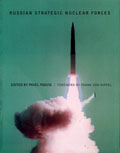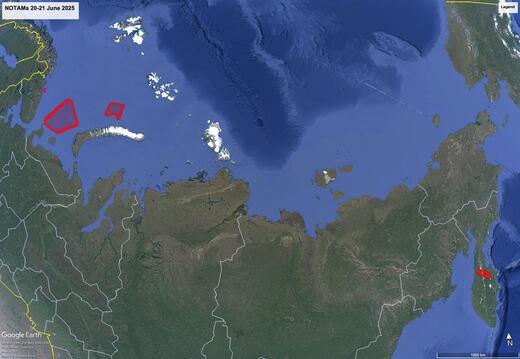 The Knyaz Pozharsky submarine of the Project 955A/Borey-A class was accepted for service in July 2025. The formal acceptance would normally take place in December, but with Knyaz Pozharsky it was postponed for about six months, presumably to complete the trials which include a test launch of a Bulava missile.
The Knyaz Pozharsky submarine of the Project 955A/Borey-A class was accepted for service in July 2025. The formal acceptance would normally take place in December, but with Knyaz Pozharsky it was postponed for about six months, presumably to complete the trials which include a test launch of a Bulava missile.
It is not clear if the expected test launch actually took place. In June 2025 Russia submitted NOTAM notifications that correspond to a Bulava test from the Barents Sea to Kura during the 20-21 June 2025 window (kmz file, h/t EM for identifying the dates). There were no reports about the launch, however. This does not necessarily mean the launch failed, although it is unusual to see a successful test not being officially reported. It's not unprecedented - see a launch in 2016 and in 2023 - but rather rare. Also, these were not state acceptance launches.
One sign that may indicate a scrubbed launch is the NOTAM cancellation record. Or, rather, lack thereof. NOTAMs were not cancelled and just expired when the announced launch window ended at 17:00 on 21 June 2025 (it opened at 05:00 on 20 June 2025). Normally, a NOTAM is cancelled right after a successful launch. See, for example, the Sineva launch on 22 October 2025 - the NOTAM covered the window from 21 October to 28 October, but was cancelled at 12:48 on 22 October 2025, right after the launch. This may not be very conclusive, however - the June window was rather narrow and the launch may have taken place close to its end anyway.
At this point I would wait for more evidence one way or another. It does appear that the launch was scrubbed, but I don't think it can be said with certainty.
 On 28 November 2025, local Russian media and then Telegram channels reported an explosion near Yasnyy in Orenburg oblast. The town is close to the old basing area of the 13th missile division.
On 28 November 2025, local Russian media and then Telegram channels reported an explosion near Yasnyy in Orenburg oblast. The town is close to the old basing area of the 13th missile division.
A full video of the incident shows the missile making an effort to right its trajectory. At about 7 seconds into the flight, the first stage engine visibly fails, the missile begins to tumble, and catches fire shortly afterwards. Interestingly, at about 15 seconds, something is ejected from the head section of the missile. This could be a payload salvage sequence.
The silo that was used for the launch has been identified as one of the silos of the 621st missile regiment, located at 50.97280, 59.55149. This silo was used for Dnepr space launches in the past (Dnepr was a converted R-36MUTTH ICBM). The last Dnepr launch was in 2015, so the silo had not been used since then. However, starting in the spring of 2025, some construction activity was detected at the site.
By all indications, it was an attempt to conduct a regular ICBM test launch with the missile delivering its warhead(s) to the Kura test site in Kamchatka. Russia issued NOTAMs for Yasnyy as well as for Kura.
The type of the missile is rather difficult to determine, but most likely it was an attempted test launch of the Sarmat ICBM. The other two possibilities are a UR-100NUTTH/SS-19 missile with Avangard and an R-36M2/SS-18.
SS-19 can be ruled out as the video shows a cold launch from a silo, while SS-19 uses a hot launch. Here is an Avangard test in 2018 that shows it very clearly. Interestingly, Avangard tests also used one of the 621st missile regiment's silos, the one at 51.030849,59.690144.
As for R-36M2, the missile has not been tested for quite a while. The last launch of the missile apparently took place in October 2013. While some of these missiles may still be deployed, it is extremely unlikely that the Rocket Forces would want to test launch them.
This leaves Sarmat. Normally, Sarmat would be launched from Plesetsk, but the Yubileynaya test silo there was destroyed in a test in September 2024. No activity has been detected in Plesetsk since then, so it appears that the tests were moved to Dombarovskiy.
So, it appears to be another setback for the Sarmat program, and it appears highly unlikely that the missile will be deployed in 2025, as was announced by the Russian president earlier this month.
UPDATE: Post-incident satellite images of the site (as of November 29, 07:31 UTC).
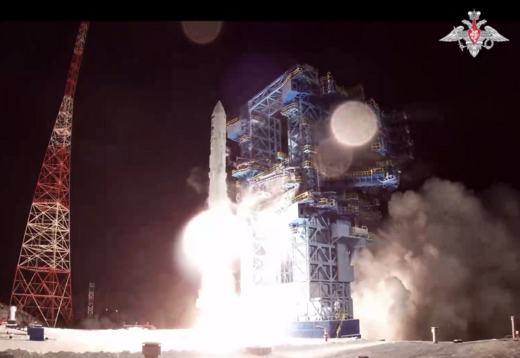 On 25 November 2025, at 16:42 MSK (13:42 UTC) crews of the Air and Space Forces conducted a successful launch of an Angara 1.2 launcher from the launch pad 1 of the launch complex 35 of the Plesetsk test site. The ministry of defense published the video of the launch.
On 25 November 2025, at 16:42 MSK (13:42 UTC) crews of the Air and Space Forces conducted a successful launch of an Angara 1.2 launcher from the launch pad 1 of the launch complex 35 of the Plesetsk test site. The ministry of defense published the video of the launch.
The launcher and its AM boost stage delivered into orbit three satellites, which are likely to be designated Cosmos-2597, Cosmos-2598, and Cosmos-2599. The satellites received international designations 2025-273A, 2025-273B, and 2025-273C and NORAD numbers 66647, 66648, and 66649 respectively. After maneuvers the satellites were deployed in nearly circular orbits with altitude of about 1500 km and inclination of 82.5 degrees.
The satellites are believed to be Rodnik communication satellites. Previous launch of three Rodnik satellites took place in March 2025.
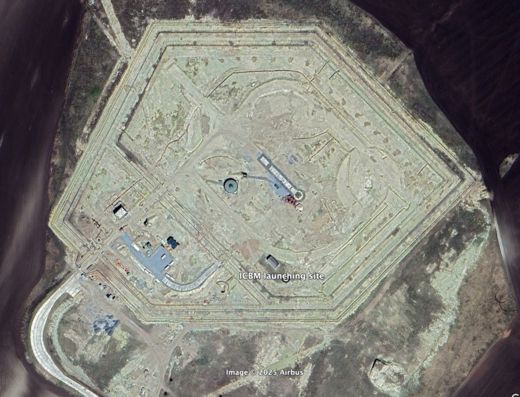 Speaking at the award ceremony for the designers of Burevestnik and Poseidon, the Russian president mentioned another strategic system, Sarmat:
Speaking at the award ceremony for the designers of Burevestnik and Poseidon, the Russian president mentioned another strategic system, Sarmat:
This year, we will put the Sarmat heavy intercontinental ballistic missile system through combat trials, and next year, deploy it on combat duty.
The official translation is somewhat inaccurate as he didn't say "will put through combat trials." It was "will put on experimental combat duty," which is a different concept. "Combat trials" gives an impression of a program that involves test launches. The "experimental combat duty" would not involve anything of this kind. It is a fairly common practice that goes back to the Soviet days. Normally, it means that a system is turned over to the military with the idea that designers continue to work on it while it is already deployed.
Sarmat has been in development for quite some time. It surfaced in 2010 and the contract was awarded to the Makeyev Design Bureau in 2011. The optimistic projections made in 2013 put the deployment date in 2018-2020. The program, however, fell seriously behind the schedule. So far, there was only one successful flight test of the missile, in April 2022. The biggest setback was the explosion in September 2024 that destroyed the Yubileynaya test silo at the Plesetsk test site.
Meanwhile, the preparations for deployment at the Uzhur missile division are well underway (as documented by the FAS team in a recent post). It is quite likely that by the end of 2025 one Sarmat missile will be placed in one of the silos. This could certainly count as an "experimental combat duty."
It would be rather unusual (to put it mildly) if the missile is accepted for service without further flight tests. As of November 2025, there are no signs that the silo at Plesetsk is being restored, so it's not clear what the plan is. One option would be to do a flight test from Uzhur, where the missile is to be deployed. It is not clear, however, whether there are designated stage impact areas for launches from Uzhur.
The bottom line is that there is a good chance we will see Sarmat in Uzhur in 2025. I would be much more skeptical about the prospect of Sarmat starting full combat duty in 2026, though. For this to happen, the missile must demonstrate that it can fly. On the other hand, if it's just sitting in a silo, does it really matter?
Image: Google Earth image (2024) of one of the silos at Uzhur (55.034722, 89.729583) prepared for the deployment of Sarmat.
 On 27 October 2025 the President of Russia signed a federal law that denounced the US-Russian Plutonium Management and Disposition Agreement. This law ended another chapter in the history of US-Russian cooperation. The factual account, with links to documents, is on the IPFM blog. I will mention two important points here, though.
On 27 October 2025 the President of Russia signed a federal law that denounced the US-Russian Plutonium Management and Disposition Agreement. This law ended another chapter in the history of US-Russian cooperation. The factual account, with links to documents, is on the IPFM blog. I will mention two important points here, though.
One is that the obligation not to use the PMDA material (which is 34 tonnes of weapons-grade plutonium) for any military purpose remains in place. When Russia suspended its participation in the PMDA in 2016, it did so by a presidential decree that clearly stated that the PMDA material "shall not be used for the purposes of manufacturing nuclear weapons or other nuclear explosive devices, for research, development, design, or testing related to such devices, or for any other military purposes."
The denunciation law did not revoke this obligation and we should assume that it is still in force unless a new presidential decree revokes the 2016 one. But, of course, the real reason we can be certain that neither Russia nor the United States will use PMDA material for weapons is that they don't need to -- they have much more weapons-grade plutonium than they know how to use.
Another point worth making is that even though it may seem insignificant--who cares about PMDA plutonium?--the way the United States handled the PMDA did a lot of damage to the US-Russian relations. Back in the day, I wrote an article in the Bulletin of the Atomic Scientists where I tried to describe the problem. In brief, the PMDA is one of the (relatively) rare cases when the US was at fault for violating an agreement. When the United States decided to change the plutonium disposition method, it decided that it did not want to wait for Russia's explicit approval despite a clear requirement to do so. Russia didn't really care about the plutonium, but it had reasons to be concerned about this disregard of a legally binding obligation. Where is the respect of your treaty obligations when you need it?
Image: A mock-up of a container that is used to store weapon-origin plutonium at the Mayak Plant Fissile Material Storage Facility.
 When Russia held its annual strategic exercise on 22 October 2025, the Chief of the General Staff said that the purpose of the exercise was to "practice the procedures for authorizing the use of nuclear weapons." This prompted me to check how the goals of these exercises were described in the past.
When Russia held its annual strategic exercise on 22 October 2025, the Chief of the General Staff said that the purpose of the exercise was to "practice the procedures for authorizing the use of nuclear weapons." This prompted me to check how the goals of these exercises were described in the past.
A big caveat is that we don't know if the stated goals of the exercises described in (usually brief) official statements have anything to do with the actual purpose of these exercises. The official statements are rather broad and vague anyway. For example, it's likely that testing of the authorization procedures is included in every such exercise, not just in the 2025 one. Having said that, here are the notes on past exercises in reverse chronological order:
According to the Chief of the General Staff, the goal of the exercise was to "practice the procedures for authorizing the use of nuclear weapons."
The exercise involved a mobile Yars launch from a Krona shelter, a launch of a Sineva SLBM, and launches of ALCMs from Tu-95MS bombers. The Krona shelter was a bit unusual (although not unprecedented - see the Yars launch in 2017, for example). One can imagine that this fits the declared goal of the exercise - mobile missiles in Krona shelters are on full alert and can be launched from there. After receiving authorization, of course.
I should note that the defense minister used the correct term, "strategic nuclear forces," after many years of "strategic offensive forces" (see below). I'd take it as a positive development, even if very small.
According to the defense minister, the exercise tested procedures of "a massive nuclear strike by the strategic offensive forces in response to a nuclear strike by an adversary" (0:15 in the video). Curiously, he said "strategic offensive forces (стратегические наступательные силы)," which is a term that is used in treaties but probably not quite appropriate in this context. "Strategic nuclear forces (стратегические ядерные силы, СЯС)" or "strategic deterrence forces" would have been better. This may be insignificant, but it does provide a glimpse into the inner workings of the military bureaucracy, which is ultimately responsible for putting together official statements. The text announcement did not mention any of that. It simply said that the exercise evaluated "the level of preparedness of military command bodies and the skills of command and operational personnel in organizing the management of subordinate forces."
The exercise itself included launches of a mobile Yars from Plesetsk, Sineva from Novomoskovsk submarine, and ALCMs from two Tu-95MS. In addition to these, the exercise included a launch of a Bulava missile from the Knyaz Oleg submarine deployed in the Sea of Okhotsk. It was the first Bulava launch from the Pacific Fleet. The initial plan was to do it in 2023, but the launch was moved to 2024 eventually.
The brief report on the Kremlin web site is very generic - "the level of preparedness of military command bodies and the skills of command and operational personnel in organizing the management of subordinate forces." Alas, there is no video, so if someone said something about a different objective, it hasn't been shown.
This was a standard exercise - a mobile Yars from Plesetsk, Sineva from a Project 667BDRM submarine (Tula this time), and ALCMs from two Tu-95MS. There was a plan to launch a Bulava from the Sea of Okhotsk, but it was cancelled.
The defense minister reported that the goal was to "work out tasks for delivering a massive nuclear strike by strategic offensive forces in response to an enemy nuclear strike." Note the "strategic offensive forces," which also appeared in 2024. My guess is that they just use a template without actually getting the language vetted by someone who would care about these things.
The composition of the forces that participated in the exercise is very standard - a mobile Yars, Sineva (from Tula submarine this time), and ALCMs from two Tu-95 MS.
This is the exercise that was supposed to take place in October 2021, but that was moved to February 2022 for reasons that became very clear five days later. The change of date may suggest that the decision to invade was made in early October 2021, although it's not conclusive as there are other ways to explain the move.
This time the description of the goals is very telling. The Chief of the General Staff said that the main goal of the exercise was to "work out procedures that allow strategic offensive forces to deliver guaranteed defeat to an adversary." The exercise was conducted in two stages. The first one was to "work out procedures for conducting operations with weapons of elevated potential danger." The second one was aimed at testing procedures for "sanctioning and massive employment of strategic offensive forces of the Russian Federation in a strike from under attack [otvetno-vstrechnyy udar]." (Note "strategic offensive forces" again.)
"Weapons of elevated potential danger" are clearly nuclear weapons. It's worth noting that the operations with these weapons were not supposed to be in response to anything. The scenario appears to have assumed that it would be Russia who would conduct these operations. And, presumably, the other assumption was that these operations would lead to an attack against Russia, which would then be forced to strike from under said attack. That was quite a scenario for the invasion that was planned to be launched on 24 February 2022. I actually think there is a good chance that the Russian leader was prepared to bear the risk of escalation all the way to the level of "massive attacks."
The types of weapons that participated in the exercise corresponded well to the scenario. In addition to the standard "strategic" part of the exercise--mobile Yars, Sineva (from Karelia), and two Tu-95MS--there was a non-strategic one. It included launches of a Kinzhal, Kalibr and Tsirkon (from submarines), as well as of an Iskander cruise missile at the Kapustin Yar test site.
In 2020, the exercise did not take place in October, although probably for a different reason than in 2021-2022. It was a COVID year and it is possible that it took the military some time to adjust to the pandemic. It was an almost standard exercise otherwise - a mobile Yars, Sineva, and ALCMs from strategic bombers. The "almost" qualifier is here because the exercise involved Tu-160 along with Tu-95MS. It's interesting that Tu-160 stopped participating in the fall exercises after 2020, although they continue to go on patrol a couple of times a year.
The event was described as an "exercise on the command and control of strategic offensive forces" that involved "practicing the practical actions of launcher crews." Not very detailed, but note the "offensive forces" again.
Another interesting note on the December 2020 exercise is that it was originally supposed to include a Bulava launch from a submarine of the Pacific Fleet. Russia released a corresponding NOTAM, but no launch took place on 9 December 2020. However, a launch took place a few days later, on 12 December 2020.
The 2019 exercise appears to be the last that had an official name, Grom-2019 in this case. It was also the last time the official announcement used the correct term, "strategic deterrence forces" (well, almost). It's "offensive forces" after that.
There was no official description of the scenario of the exercise, only a mention that "during the event, a verification was carried out of the preparedness level of military command bodies and the work skills of command and operational personnel in organizing command and control of subordinate forces." Of course it was.
The exercise involved a Yars launch, two SLBM launches--Sineva from Karelia in the Barents Sea and older R-29R from a Ryazan submarine from the Sea of Okhotsk--and ALCMs launched from Tu-95MS. It appears that more than the usual two bombers participated, since the ALCMs were launched toward two different test sites--Kura in Kamchatka and Pemboy in Komi Republic.
The good news is that at that point someone still cared about correct terminology. The official report describes an exercise of "strategic nuclear forces." As for the goal, it was not clearly described. The report just says that
During the exercise, the Armed Forces command system was tested, as well as the reliability of transmitting training and combat orders and signals through the entire command hierarchy from the National Defense Control Center of the Russian Federation to the command posts of formations and military units.
It's quite a mouthful, but passive voice is quite common in Russian (like in "mistakes were made"). I would say that it's probably close to the practicing of "the procedures for authorizing the use of nuclear weapons" that appeared in the 2025 report.
The 2019 exercise was quite unusual because it involved no ICBM launches. Or it looks like it did, but the launch was cancelled. The navy launched a Sineva from Barents Sea (Tula submarine) and R-29 from the Sea of Okhotsk. Both Tu-160 and Tu-95MS bombers took part in the exercise, along with Tu-22M3, which are technically included in long-range aviation.
Earlier exercises
I should probably stop here. We can see that at this point official announcements of the exercises had a somewhat different format and did not really include stated goals. It's interesting to note that the change to the new format coincided with the adoption of the term "strategic offensive forces" and with dropping the Grom name. I wouldn't be surprised if it was a result of a personnel change.
In terms of participating units, one can probably say that exercises have gradually become simpler. Even in the 2021/2022 one, the "strategic" part was pretty basic. The disappearance of Tu-160 is also somewhat interesting.
To conclude, here is the list of the fall exercises that I managed to locate in my blog:
- 26 October 2017
- 12 October 2016
- 30 October 2015
- 8 May 2014 (May !?)
- 30 October 2013
- 19 October 2012 - Topol ICBM, R-29R missile, bombers
- 12 October 2008 - Stabilnost-2008, Topol, SLBMs, bombers
I don't have a record of earlier large-scale exercises. I hope it's not because I missed them but because of the tradition of having a big exercise in the fall only started in 2012 (Stabilnost-2008 seems an outlier). In any event, it was useful to check the old records and to see how these exercises have evolved. At the very least, they are all in one post now.
(The image is from the 2017 exercise. The photo was taken by a Tomsk photographer Alexey Yakovlev)
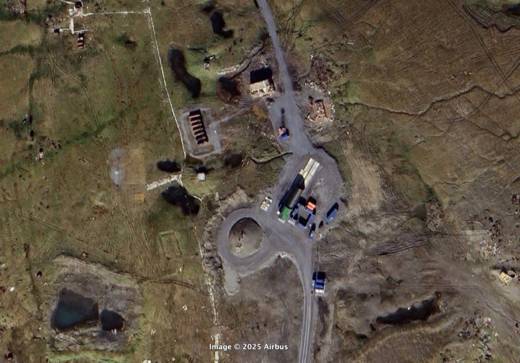 On 21 October 2025 Russia conducted what was described as the key test of the Burevestnik nuclear-powered cruise missile (also referred to as SSC-X-9 Skyfall).
On 21 October 2025 Russia conducted what was described as the key test of the Burevestnik nuclear-powered cruise missile (also referred to as SSC-X-9 Skyfall).
The test was discussed at a meeting of the President of Russia and the military command on 26 October 2025. The relevant exchange starts at 9:15 in the official video.
The Chief of the General Staff reported that the test took place on 21 October 2025 and that "unlike in previous tests, this time the missile covered the distance of 14,000 km. And this is not a limit." He later added that the missile was in flight for about 15 hours. The missile used its nuclear propulsion system during the flight and conducted a series of "vertical and horizontal maneuvers" demonstrating the capability to evade air- and missile defense.
The president noted that "it will be necessary to decide how to classify this type of armament (presumably to distinguish it from regular cruise missiles), to determine the possible ways of employing this system, and to start preparing the infrastructure for the deployment of this weapon in our armed forces."
Activity at the Pan'kovo site (73.115550, 53.271458, see the image above) related to Burevestnik tests was noted by many observers in August 2025. It's possible that some (short-range) tests were indeed conducted at the time. Regarding the infrastructure for deployment, in September 2024, Decker Eveleth located what appears to be a Burevestnik deployment site (see also his April 2025 update). It is at 59.1088, 38.6372, right next to the Vologda-20 nuclear weapons storage facility (on those, see this post).
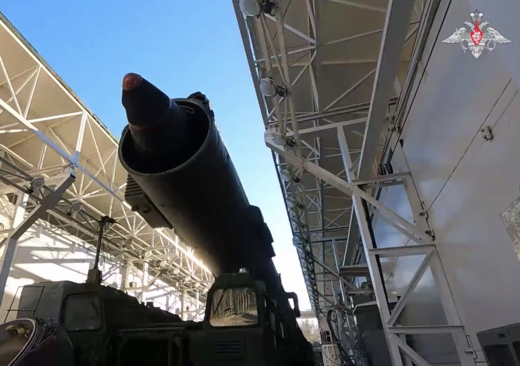 On 22 October 2025 Russian armed forces conducted a regular exercise of strategic forces (in English). This is an annual exercise that is traditionally held in the fall. The previous one was held on 29 October 2024. As in previous years, the President of Russia participated in the exercise from the National Defense Control Center. According to the official announcement, the exercise "evaluated the readiness of military command bodies and the operational staff's proficiency in organising and managing the troops (forces) under their command." The Chief of the General Staff was a bit more specific - the goal of the exercise was to "practice the procedures for authorizing the use of nuclear weapons." (Note that in 2024, it was a test of procedures of "a massive nuclear strike in response to a nuclear strike by an adversary").
On 22 October 2025 Russian armed forces conducted a regular exercise of strategic forces (in English). This is an annual exercise that is traditionally held in the fall. The previous one was held on 29 October 2024. As in previous years, the President of Russia participated in the exercise from the National Defense Control Center. According to the official announcement, the exercise "evaluated the readiness of military command bodies and the operational staff's proficiency in organising and managing the troops (forces) under their command." The Chief of the General Staff was a bit more specific - the goal of the exercise was to "practice the procedures for authorizing the use of nuclear weapons." (Note that in 2024, it was a test of procedures of "a massive nuclear strike in response to a nuclear strike by an adversary").
As in previous years, the exercise involved a launch of a Yars missile from a mobile launcher in Plesetsk, a launch of a Sineva missile from a submarine of the Project 667BDRM/Delta IV class from the Barents Sea (Bryansk), and launches of ALCMs conducted by Tu-95MS bombers. The official Telegram channel of the ministry of defense published videos of the launches.
During the Yars launch, the launcher was placed inside a Krona shelter (the video includes a shot from inside the shelter). Official reports do not say how many Tu-95MS bombers took part in the exercise, but normally these exercises include two aircraft.
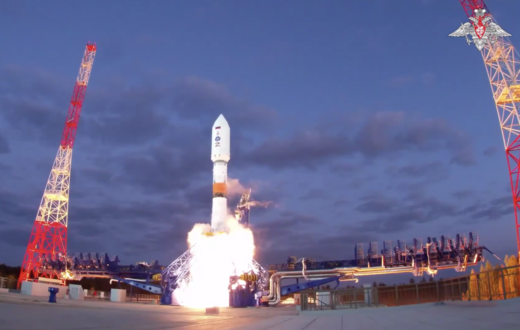 The Air and Space Forces conducted a successful launch of a Soyuz-2.1b rocket from the launch pad No. 3 of the launch complex No. 43 of the Plesetsk space launch site (Ministry of Defense video). The launch took place at 05:10 MSK on 13 September 2025 (02:10 UTC). The satellites that the rocket and its Fregat boost stage delivered into orbit are a 14F143 Glonass-K navigation satellite No. 18L and a Mozhaets-6 research satellite.
The Air and Space Forces conducted a successful launch of a Soyuz-2.1b rocket from the launch pad No. 3 of the launch complex No. 43 of the Plesetsk space launch site (Ministry of Defense video). The launch took place at 05:10 MSK on 13 September 2025 (02:10 UTC). The satellites that the rocket and its Fregat boost stage delivered into orbit are a 14F143 Glonass-K navigation satellite No. 18L and a Mozhaets-6 research satellite.
The satellites received designation Cosmos-2595 and Cosmos-2596 (at the moment it's not entirely clear which satellite is which). Their international designations are 2025-206*. NORAD lists two objects, 65589 and 65590 (as well as 65591 identified as a rocket body).
Previous Glonass launch, of a Glonass-K2 satellite, took place in March 2025. Launch of a Glonass-K satellite took place in October 2022.
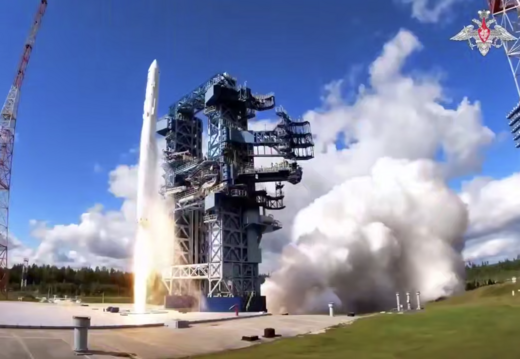 On 21 August 2025, at 12:32 MSK (09:32 UTC) crews of the Air and Space Forces conducted a successful launch of an Angara 1.2 launcher from the launch pad 1 of the launch complex 35 of the Plesetsk test site. (Video of the launch)
On 21 August 2025, at 12:32 MSK (09:32 UTC) crews of the Air and Space Forces conducted a successful launch of an Angara 1.2 launcher from the launch pad 1 of the launch complex 35 of the Plesetsk test site. (Video of the launch)
The launcher delivered into orbit four satellites, that were deployed in almost circular 319x327 km orbits with inclinations of 96.59 degrees. No Cosmos designations for the satellites has been announced. In the NORAD catalog they are registered as OBJECT A/2015-182A/65267, OBJECT B/2015-182B/65268, OBJECT C/2015-182C/65269, and OBJECT D/2015-182D/65270. If OBJECT C from the 19 June 2025 launch was designated as Cosmos-2590, these satellites would be designated as Cosmos-2591 to Cosmos-2594. [UPDATE: Yes, these are apparently the satellites' designations. They are believed to be 14F178 MKA satellites Nos. 7 to 10.]
The satellites are believed to be optical reconnaissance satellites, probably similar to Cosmos-2577 and Cosmos-2578, launched in September 2024.
